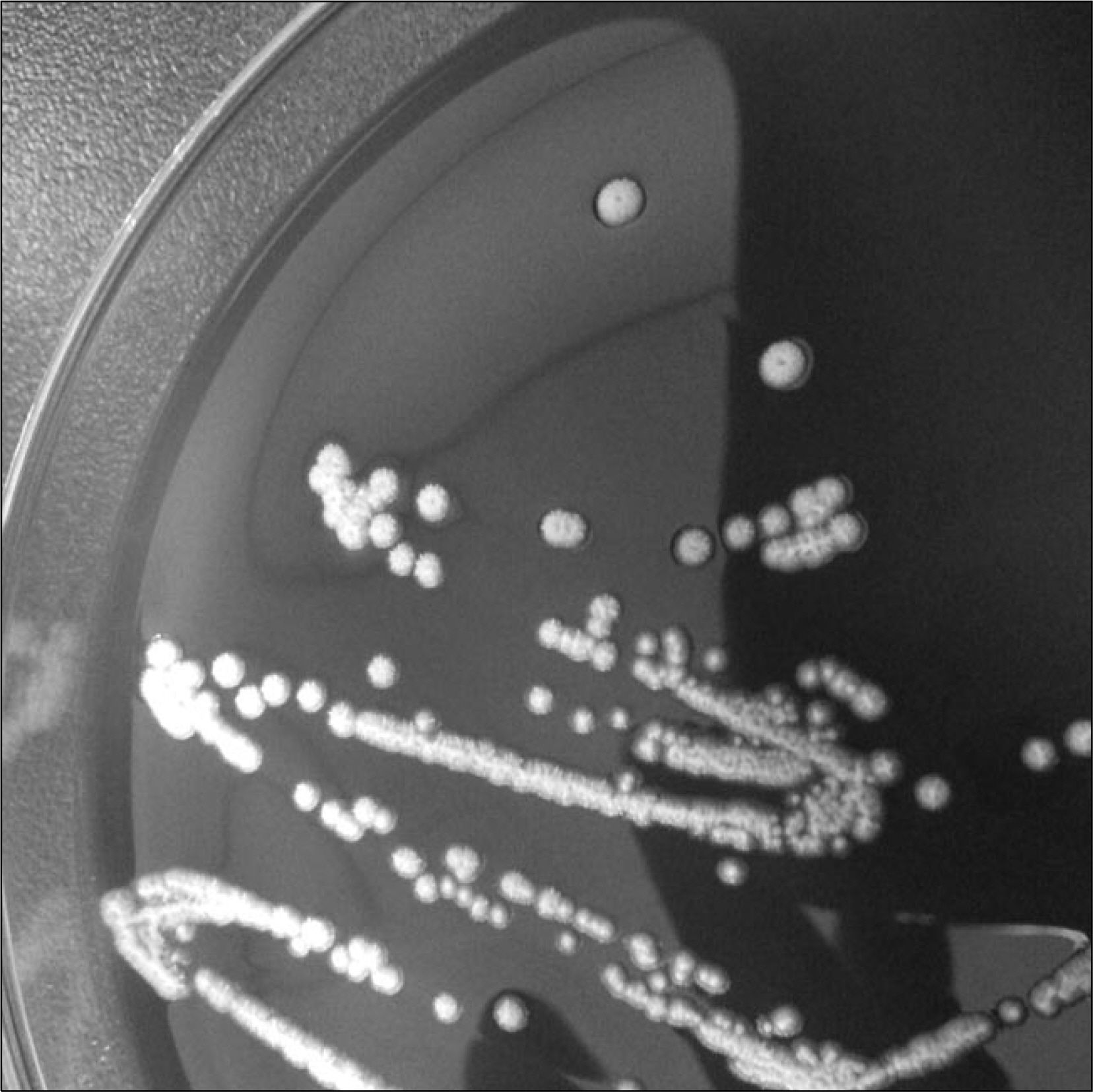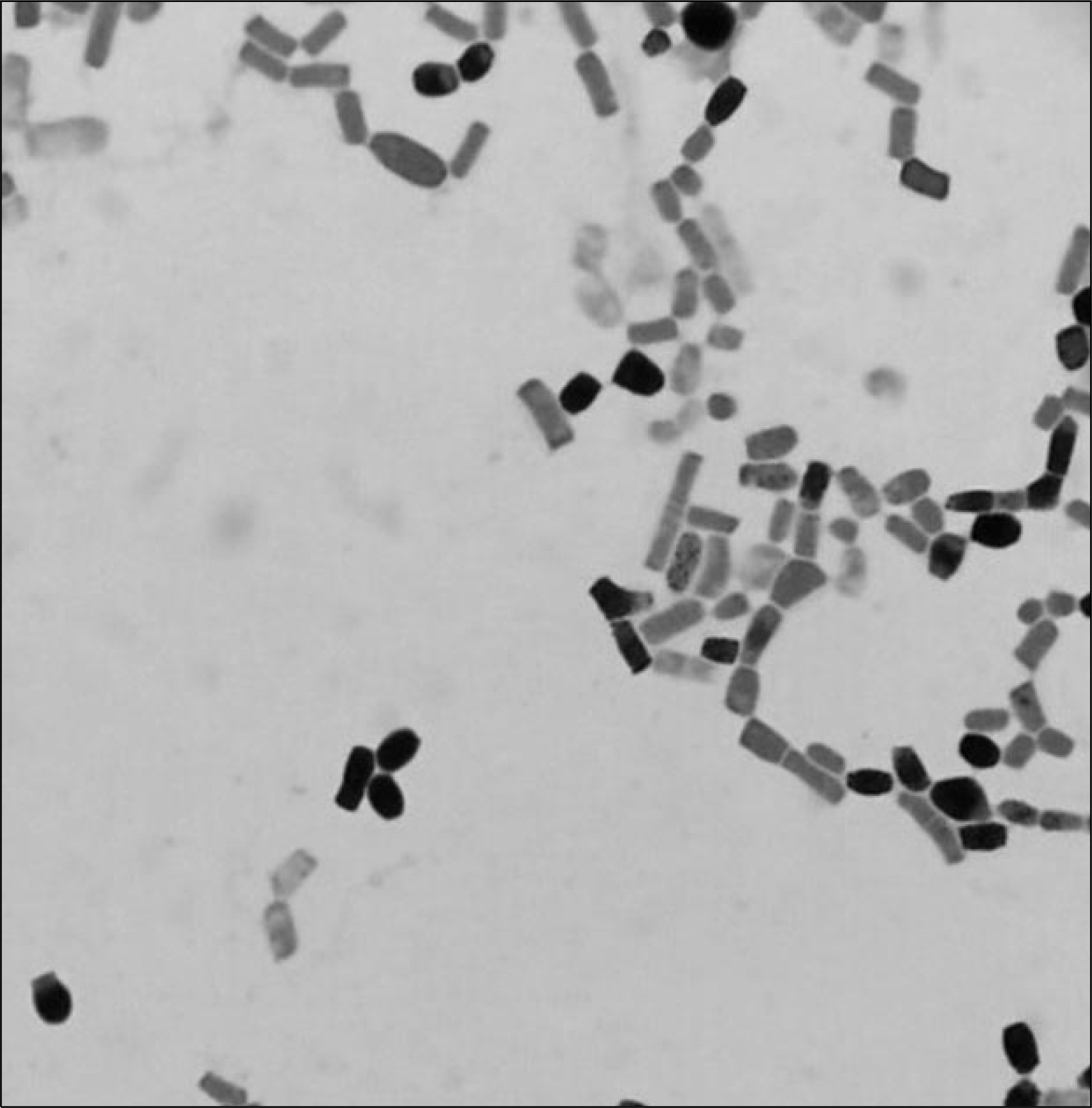Ann Clin Microbiol.
2015 Jun;18(2):56-59. 10.5145/ACM.2015.18.2.56.
A Case of Trichosporon asahii Fungemia with Urinary Tract Infection as a Primary Focus
- Affiliations
-
- 1Department of Laboratory Medicine, Kyungpook National University Hospital, Daegu, Korea. leewk@knu.ac.kr
- 2Kyungpook National University Hospital-National Culture Collection for Pathogens, Daegu, Korea.
- KMID: 1971113
- DOI: http://doi.org/10.5145/ACM.2015.18.2.56
Abstract
- Since the report of disseminated trichosporonosis in 1970s, several cases of infection by various Trichosporon species in different clinical patients were published. We've isolated a strain of T. asahii from not only blood but also urine. We report 71 year-old male patient with Trichosporon asahii fungemia, who had renal stones. It was identified as T. asahii using conventional method and also confirmed by 18S rRNA gene sequencing. The patient was discharged without any complication, in which case only antibiotic agent was used without any antifungal one.
Keyword
Figure
Reference
-
1.Pritchard RC., Muir DB. Trichosporon beigelii: survey of isolates from clinical material. Pathology. 1985. 17:20–3.2.Walsh TJ., Melcher GP., Lee JW., Pizzo PA. Infections due to Trichosporon species: new concepts in mycology, pathogenesis, diagnosis and treatment. Curr Top Med Mycol. 1993. 5:79–113.3.Colombo AL., Padovan AC., Chaves GM. Current knowledge of Trichosporon spp. and Trichosporonosis. Clin Microbiol Rev. 2011. 24:682–700.4.Taverna CG., Córdoba S., Murisengo OA., Vivot W., Davel G., Bosco-Borgeat ME. Molecular identification, genotyping, and antifungal susceptibility testing of clinically relevant Trichosporon species from Argentina. Med Mycol. 2014. 52:356–66.5.Tashiro T., Nagai H., Kamberi P., Goto Y., Kikuchi H., Nasu M, et al. Disseminated Trichosporon beigelii infection in patients with malignant diseases: immunohistochemical study and review. Eur J Clin Microbiol Infect Dis. 1994. 13:218–24.6.Walsh TJ. Trichosporonosis. Infect Dis Clin North Am. 1989. 3:43–52.
Article7.Chen J., Chen F., Wang Y., Yang LY., Miao M., Han Y, et al. Use of combination therapy to successfully treat breakthrough Trichosporon asahii infection in an acute leukemia patient receiving voriconazole. Med Mycol Case Rep. 2014. 6:55–7.8.Ryu JH., Kim TH., Kweon OJ., Lee MK. Profiles of yeast isolated from urinary tracts with and without catheter during 2011-2013. Korean J Urogenit Tract Infect Inflamm. 2014. 9:93–8.
Article9.Song JS., Choe PG., Song KH., Park KU., Park WB., Park SW, et al. Multiple opportunistic infections and primary central nervous system lymphoma in a patient with idiopathic CD4+ T-lymphocytopenia. Infect Chemother. 2012. 44:17–21.
Article10.Jang MJ., Lee YK., Han KC., Hong SG., Kang MS., Oh D, et al. A case of Trichosporon beigelii fungemia treated with amphotericin B and fluconazole in a patient with acute myelogenous leukemia. Korean J Hematol. 2004. 39:109–12.11.Lim H., Kim DS., Lee HS., Choi SI. A case report of invasive infection due to Trichosporon beigelii in a patient with acute leukemia. Korean J Clin Microbiol. 2002. 5:151–4.12.Lee HS., Choi JH., Kim SM., Shim YK., Seong MH., Kim HY, et al. A case of Trichosporon inkin continuous ambulatory peritoneal dialysis peritonitis identified by 18S rRNA sequencing. Korean J Nephrol. 2011. 30:561–4.13.Yang JI., Kim MA., Jung EY., Baek JE., Ha HJ., Kim HJ, et al. A case of Trichosporon beigelii peritonitis in CAPD. Korean J Nephrol. 2004. 23:518–22.14.Kim JS., Yang JW., Kim MS., Han ST., Uh Y., Han BG, et al. Peritonitis due to Trichosporon asahii in a continuous ambulatory peritoneal dialysis patient. Korean J Med. 2008. 75:714–7.15.Kim M., Jeong WS., Kim HW., Kim YR., Lee KH., Jang EH. A case of Trichosoporon insectorum peritonitis in a continous ambulatory peritoneal dialysis patient. Korean J Nephrol. 2011. 30:346–50.16.Kumar S., Bandyopadhyay M., Mondal S., Pal N. A rare case of nosocomial urinary tract infection due to Trichosporon asahii. J Glob Infect Dis. 2011. 3:309–10.17.Sabharwal ER. Successful management of Trichosporon asahii urinary tract infection with fluconazole in a diabetic patient. Indian J Pathol Microbiol. 2010. 53:387–8.18.Sun W., Su J., Xu S., Yan D. Trichosporon asahii causing nosocomial urinary tract infections in intensive care unit patients: genotypes, virulence factors and antifungal susceptibility testing. J Med Microbiol. 2012. 61:1750–7.19.Hashino S., Takahashi S., Morita R., Kanamori H., Onozawa M., Kawamura T, et al. Fungemia due to Trichosporon dermatis in a patient with refractory Burkitt's leukemia. Blood Res. 2013. 48:154–6.20.Ruan SY., Chien JY., Hsueh PR. Invasive trichosporonosis caused by Trichosporon asahii and other unusual Trichosporon species at a medical center in Taiwan. Clin Infect Dis. 2009. 49:e11–7.21.Yamamoto M., Takakura S., Hotta G., Matsumura Y., Matsushima A., Nagao M, et al. Clinical characteristics and risk factors of non-Candida fungaemia. BMC Infect Dis. 2013. 13:247.
Article22.Nishiura Y., Nakagawa-Yoshida K., Suga M., Shinoda T., Guého E., Ando M. Assignment and serotyping of Trichosporon species: the causative agents of summer-type hypersensitivity pneumonitis. J Med Vet Mycol. 1997. 35:45–52.23.Ko DY., Ha SM., Jeon SY., Song KH., Kim KH. White piedra of scalp hair caused by Trichosporon asahii. Korean J Dermatol. 2013. 51:228–9.24.Lee WS., Chang SE., Kim DH., Kim MN., Choi JH., Sung KJ, et al. A case of toenail onychomycosis caused by Trichosporon asahii. Korean J Dermatol. 2002. 40:980–2.25.Hwang JH., Kim YI., Jang IG., Park HK., Lim SC., Kim YC, et al. A case of summer-type hypersensitivity pneumonitis. Chonnam Med J. 1999. 35:295–301.
- Full Text Links
- Actions
-
Cited
- CITED
-
- Close
- Share
- Similar articles
-
- A Case of Disseminated Trichosporon asahii Infection in an Immunocompromised Patient
- Catheter-Related Trichosporon asahii Bloodstream Infection in a Neutropenic Patient with Myelodysplastic Syndrome
- White Piedra of Scalp Hair Caused by Trichosporon asahii
- A Case of Fungemia with Co-isolation of Candida parapsilosis and Trichosporon asahii Confirmed by MALDI-TOF MS and D2 rRNA Sequencing
- Peritonitis due to Trichosporon asahii in a continuous ambulatory peritoneal dialysis patient



